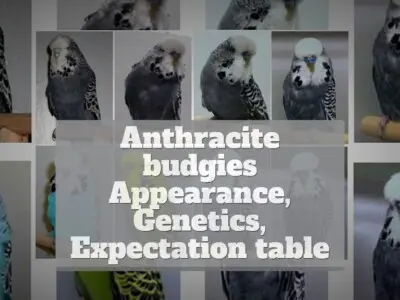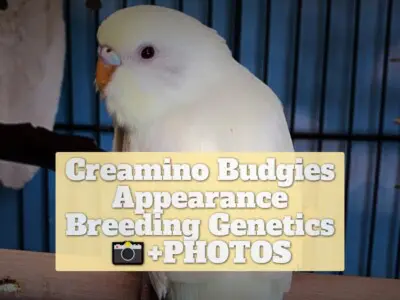Budgie breeding refers to the process of facilitating the reproduction of budgerigars, a type of small parrot.
It requires careful attention to diet, habitat, and mate selection. The process involves providing nutrition-rich food, proper nesting environment, and compatible pairs.
As a devoted bird lover and a former budgie owner, I’ve spent many delightful years observing the intricacies of budgie breeding.
Realizing the gap in comprehensive and accessible guides on the topic, I decided to put together this all-encompassing guide on Budgie Breeding: Everything You Need to Know.
Whether you’re a curious novice or a seasoned bird enthusiast, this guide aims to equip you with knowledge about this fascinating journey of breeding budgies – from understanding their mating readiness to the proper care of budgie chicks.
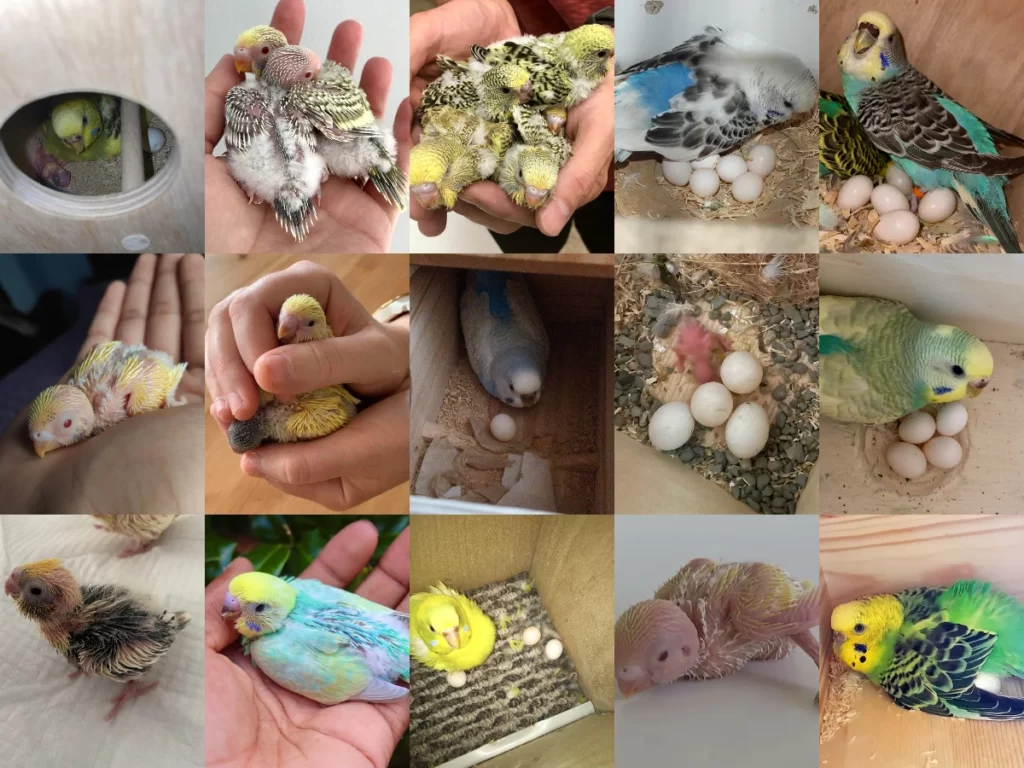
Introduction to Breeding Budgies
Breeding budgies offers an engaging and rewarding experience, especially for bird lovers. These vibrant, lively birds, not only offer an aesthetic appeal but also serve as great companions.
Understanding Budgerigar Breeding
Budgie Breeding Behavior Observations
The breeding behavior of budgies is fascinating and has a rhythm of its own.
When they are ready to breed, budgies become more active and attentive to each other.
The males court the females with enthusiastic chirping and head-bobbing. Similarly, the females respond by preening and nuzzling against the males.
In the lead up to the breeding process, it’s important to monitor the birds’ diet.
The breeding period calls for an increase in nutritional intake, including proteins, fats, carbohydrates, vitamins, and minerals.
For protein, consider boiled eggs or legumes, and for calcium, cuttlebones or eggshells can be helpful.
When Do Male and Female Budgies Start Breeding and Mating?
Budgies reach sexual maturity at around 3 to 4 months of age, but it’s recommended to wait until they are at least 6 months old before introducing them to a breeding environment.
This delay allows them to reach full physical maturity and enhances their breeding success.
What Age Do Budgies Stop Breeding? How Long until Budgies Can Breed?
Generally, female budgies can safely breed up to about 4-5 years of age, while males can continue for another year or two.
However, it is important to note that frequent breeding can decrease their lifespan, as it puts a significant amount of stress on their bodies.
Budgie Breeding Seasonality and Hormone Regulation
Budgie breeding is highly influenced by seasonal changes, which regulate their hormonal cycles.
In the wild, budgies usually breed after the rainy season when food is abundant.
In captivity, their breeding cycles can be manipulated by altering light exposure, diet, and temperature.
What Month Do Budgies Breed?
In their native Australia, budgies tend to breed after the rainy season, which falls between June and August.
However, in captivity, budgies can breed at any time of the year given the right conditions.
How Geography Affects Breeding Seasons: USA, UK, Australia, India
The breeding seasons for budgies can significantly differ depending on their geographical location.
For instance, budgies in the USA and UK often breed in the spring and summer months when daylight hours are longer.
Budgies cannot live outside in the UK but can be affected by weather conditions, day and night cycles.
Open-air budgerigar cages mimic the birds’ natural habitats, with exposure to natural light and climatic conditions, which heavily influence their breeding periods.
If the climate is too cold, too hot, or fluctuates significantly, it can stress the budgies and inhibit breeding.
In colder regions like the UK, it’s not recommended to keep budgies in outdoor aviaries year-round due to the risk of hypothermia during the winter months.
Alternatively, in extremely hot climates, budgies might suffer from heat stress, which could also negatively impact their health and breeding capabilities.
Selecting Budgies
Choosing the right budgies for breeding requires considering various factors. From their dietary needs to their compatibility with each other, it’s important to make informed choices to ensure successful breeding.
What Attracts People to Budgies
One of the main attractions to keeping and breeding budgies is their vibrant, attractive colours.

Blue budgies, green budgies, yellow budgies, and white budgies, all of which have an aesthetic appeal that captures the attention of many enthusiasts.
Moreover, their friendly nature and captivating character make them an excellent choice for adults and children alike.
The vibrant and captivating colors of budgies often draw people to keep them as pets.
Besides, these birds have delightful personalities that truly enchant. Once you witness the baby budgies start to show their colours in their nest boxes, you will undoubtedly be captivated.
First-Time Budgie Owners
Most people start with a single budgie as a pet and then consider expanding their flock.
However, budding bird keepers should be aware that budgies are colony birds.
This means they usually need to be part of a group before they start to breed successfully.
Understanding budgies’ needs and behavior is crucial for first-time owners to ensure they provide a conducive environment for their pets.
Selection of Varieties, Colors, and Genetic Mutations
Budgies come in various varieties, each carrying different sets of traits and characteristics.
When it comes to breeding budgies, there’s an element of genetics to be understood.
However, beginners need not be discouraged by this complexity.
“If you get the chance to select varieties and colours, pick the bright ones – Lutinos, Albinos, Clearwings, Spangles, and Pieds,” says Fred Wright.
Understanding the genetics of budgies can help breeders select the colours and traits they find attractive and wish to propagate.
Budgie Pairing Compatibility
When it comes to breeding budgies, pairing them correctly is key to success.
The pairs must be compatible with each other to facilitate successful breeding.
The key to reducing competitiveness and aggression is to pair-bond the pairs in separate cages for a week and then release multiple pairs into the aviary at once.
What Would Happen If the Budgies We Put Together to Mate Don’t Like Each Other or One of Them?
- Aggression: If budgies do not get along, they can display aggression towards each other. This can lead to injuries and stress, which is not conducive to breeding.
- No Breeding: Budgies that do not like each other will likely not mate. This would hinder any breeding plans.
- Distress: Budgies that are forced to share a space with a bird they don’t get along with can become distressed, which can impact their overall health.
- Neglected Eggs: If budgies don’t get along, there’s a risk that any eggs laid may be neglected, as the birds may focus more on their conflict than their potential offspring.
- Disruption to the Colony: Budgies that are incompatible can cause disruption in the colony, leading to more widespread distress and potential aggression.
Preparations for Breeding
Breeding budgies can be a delightful hobby that offers both the fun of keeping these lively birds and the pleasure of seeing them raise their young.
One of the earlier steps in this journey is to prepare your environment budgie breeding.
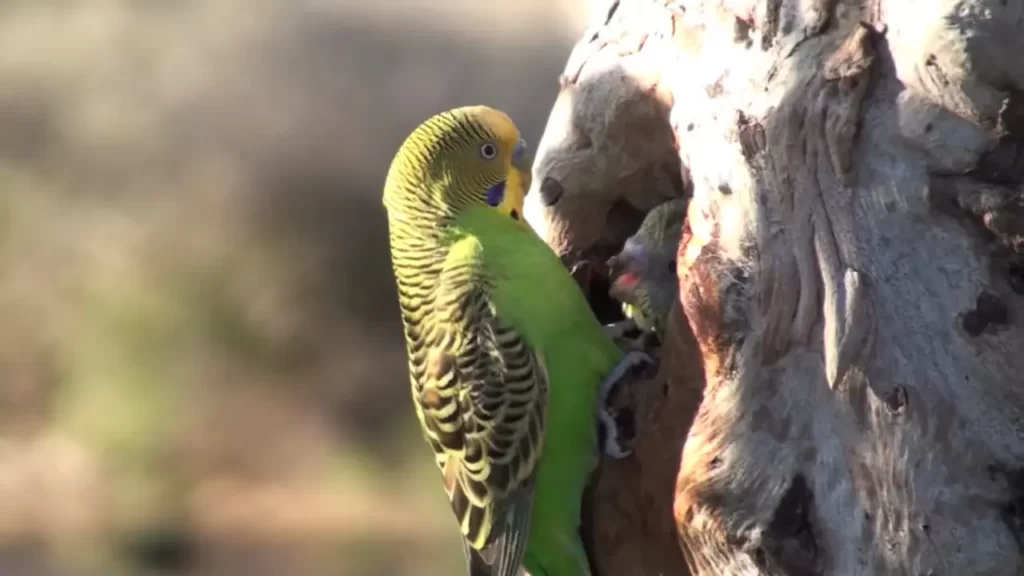
The Concept of Nesting Boxes for Budgies
Nesting boxes play a significant role in the breeding process of budgies.
The budgies breed in a nest box with the entry hole at the top or the side.
The boxes can be attached to the outside of a cage or even placed inside, given that the door is big enough. This creates a cozy, safe space for the budgies to lay their eggs and nurture their offspring.
DIY: How to Make a Budgie Nest Box Out of Cardboard?
For those interested in creating their own nesting boxes, it’s entirely possible using readily available materials like cardboard.
Make sure to create an entry hole at the top or the side.
Keep in mind that the comfort and safety of your budgies is paramount.
Therefore, the nest box should be spacious enough for the budgies and their forthcoming chicks.
But, I personally don’t recommend a nest box made of cardboard. For budgerigar nest boxes, please use untreated wood whenever possible.
Rules to Follow in Setting up the Ideal Breeding Environment
Creating an ideal breeding environment for budgies requires a few rules to be followed.
- Choosing Your Budgies: Look for bright colors and attractive varieties such as Lutinos, Albinos, Clearwings, Spangles, and Pieds. The budgies’ aesthetics are secondary to their health and vitality. Start with one pair, and gradually add more for a small colony setup.
- Proper Nesting: Utilize nest boxes with entry holes at the top or side. These boxes can be positioned inside or outside the cage. Ensure all boxes are at the same level to prevent territorial disputes among the hens.
- Breeding Method Selection: You can either breed budgies in a pair-to-cage setting with one nest box or in a small aviary or flight (colony system).
- Preventing Aggression: If you opt for the colony breeding system, pair-bond the pairs in separate cages for a week before releasing them into the aviary. This can reduce aggression and competition.
- Feeding: Provide a high-quality seed mix with a balance of nutrients required for breeding. Include a conditioner and a rearing food when hens are nurturing chicks.
- Hydration: Ensure fresh water supply daily. Water intake is crucial, especially during the breeding period.
Difference between Cage Breeding and Aviary System or Colony Breeding
When it comes to breeding budgies, there are two primary systems you can opt for: cage breeding and aviary or colony breeding.
Cage breeding involves having a pair of budgies in a cage with one nest box.
This is a more conventional approach.
On the other hand, aviary or colony breeding involves having multiple pairs in an aviary or flight with several nest boxes.
This is a more communal system, and it is known as the “colony system” or colony breeding.
Each system has its benefits and potential challenges, so it’s important to understand both before making a decision.
Dealing With Competitive and Aggressive Behavior among Budgies
Despite the beauty and charm of the colony system, it does present a unique challenge: competition and aggression among budgies.
As they start to get competitive, they can become aggressive towards each other.
One way to overcome this competitiveness is to pair-bond the pairs in separate cages for a week and then release 4 or even 6 pairs into the aviary at one time.
Usually, the pairs will stay together and the aggression seems to subside.
This aggression, while it can be stressful for the owner, is a natural part of budgie behavior.
It’s part of the excitement and challenge of breeding these delightful birds, and with the right preparation and knowledge, it’s an aspect of the hobby that can be managed effectively.
How Do You Know That Male and Female Budgie Are in Their Breeding Season?
Identifying the breeding season in budgies is crucial to successful mating and the production of healthy offspring.
Budgies, being highly active and sociable birds, display several noticeable signs that indicate they are ready for mating.
These signs can be observed in their physical appearance, behavior, and interaction with their partner.
The following sections explain these signs in male and female budgies separately.
How to Tell If a Male Budgie Wants to Mate?
Beak Color
In male budgies, the cere (skin above the beak that contains the nostrils) changes color when they are ready to mate.
The color of the beak becomes more vibrant, often shifting to a bright blue hue.
This color change is a potent sign that the male budgie is in a good condition and is ready for the breeding season.
Increased Singing and Chirping
Another sign is an increase in singing and chirping. Males will become noticeably louder and more vocal.
This behavior is a form of courtship and a way for the male to attract a female partner.
Bobbing Head and Flapping Wings
Bobbing their head and flapping their wings are common behaviors male budgies engage in to show their interest in mating.
It’s a visual performance that’s intended to impress and grab the attention of the female budgie.
Feeding the Female
This is another form of courtship. A male budgie ready for mating might start feeding the female.
This act not only symbolizes his affection but also shows his ability to provide and take care of the future chicks.
Mating Dance, Flirting
Male budgies perform a mating dance to catch the attention of the female.
This might include hopping around, flapping their wings, and moving their body in a rhythmic manner.
Tail Wagging
Tail wagging, often accompanied by chirping, is another sign that male budgies are ready to mate.
They will perform this action to demonstrate their interest to the female.
Stepping On Female Budgie
The act of a male budgie stepping on a female is a natural behavior seen in the mating process.
Male budgies often step onto the backs of the females to signal their interest and readiness to mate.
This behavior can appear aggressive to new bird owners, but it’s a part of the birds’ courtship rituals.
How to Tell If a Female Budgie Wants to Mate?
Beak Color
Just like males, female budgies also show a change in the color of their cere when ready to mate.
A female budgie cere generally turns a brownish color, indicating she is in breeding condition.
Fluffed Feathers around the Vent Area
The female budgie may fluff up the feathers around her vent area, a physical indication of her readiness to mate.
Tail Raising and Wagging
Tail raising and wagging in female budgies is an invitation for the male to mate.
She may also chirp or make other noises to grab the male’s attention.
Receptive to the Male’s Actions
A female budgie who is ready to mate will be receptive to the male’s advances.
She might respond to his songs, dances, and feeding gestures, showing interest and acceptance.
Entering the Nesting Box
Females will start spending more time in the nesting box when they’re ready to lay eggs.
They may even start arranging materials inside the box, making it comfortable for their future chicks.
Increased Agitation or Aggression
Some female budgies may display increased agitation or aggression when they are ready to mate.
This behavior might be a way to protect her space and indicate her readiness to start a family.
Tapping the Beak on a Surface
Tapping the beak on a surface, usually the floor of the cage or nest box, is another sign that the female is ready for breeding.
It’s a form of communication to the male about her readiness to mate.
Mating Posture
When ready to mate, the female budgie will adopt a specific posture.
She will crouch low on the perch, spread her wings slightly, and raise her tail, signaling to the male that she is ready for mating.
Budgie Breeding Diet and Nutrition
Budgies are fascinating birds that are often bred in captivity. Breeding these birds is not particularly complicated but requires some understanding of their specific needs, especially their nutritional requirements.
In the breeding season, budgies have increased dietary needs to support their reproductive functions.

Foods and Nutrients That Increase in Need during the Breeding Season
During the breeding season, budgies need an array of nutrients in greater quantities.
These include protein, calcium, phosphorus, vitamin D3, other vitamins and minerals, and special breeding pellets.
Let’s delve into these essential nutrients:
Protein
Protein is crucial for budgies, especially during the breeding season, because it supports the growth and development of their chicks.
To meet this increased need, consider adding high-protein foods such as boiled eggs (including the shell for calcium) to their diet.
Calcium
Calcium is another essential nutrient that needs to be increased during the breeding period.
This mineral helps in egg production and aids the development of strong bones in chicks.
You can increase the calcium intake by providing cuttlebones, eggshells, or calcium supplements.
Phosphorus
Phosphorus is another mineral important for budgies. It works closely with calcium to ensure optimal bone health.
Vitamin D3
Vitamin D3 helps budgies absorb calcium and phosphorus. Supplementing vitamin D3 it in the diet is beneficial, especially in the breeding season.
You can use a vitamin D3 supplement or provide foods like egg yolks.
Vitamins and Minerals
Vitamins and minerals play a crucial role in budgie health. During the breeding season, their need for these nutrients increases.
To supplement these, increase the variety and amount of fresh fruits and vegetables in their diet.
Some great choices include carrots, peas, corn, apples, and leafy greens like spinach or kale.
Special Breeding Pellets
Some brands offer specially designed pellets for the breeding period. These pellets contain a balanced mix of all the necessary nutrients required by the birds during this time.
This can be an excellent supplement during breeding. If you are serious about breeding budgies, I recommend you to research this kind of sepecial bird food.
What Is Budgie Breeding Diet?
The budgie breeding diet is a special diet tailored to meet the increased nutritional needs of budgies during their breeding season.
While a budgie’s regular diet consists mainly of seeds, the breeding diet is more varied and nutrient-dense.
As the breeding season approaches, a budgie’s diet should gradually shift to include more proteins, vitamins, minerals, and specific items like special breeding pellets.
Protein sources such as boiled eggs become crucial during this time to support egg production and chick growth.
The intake of calcium, vital for egg production, should also be increased.
This can be achieved by providing cuttlebones or eggshells. Similarly, the inclusion of a greater variety of fruits and vegetables ensures the birds get a wide array of vitamins and minerals.
Sprouted seeds are another valuable addition to the diet, as they are more nutritious than dried ones.
Besides, special breeding pellets can help ensure budgies receive all necessary nutrients.
Water consumption also tends to increase during the breeding period. Fresh water should be made available at all times, as it is necessary for drinking, bathing, and humidifying the nest.
What Is the Role of Cuttlebones, Mineral Blocks, Calcium Blocks, and Eggshells in Budgie Breeding?
Cuttlebones, mineral blocks, calcium blocks, and eggshells are essential dietary supplements in budgie breeding.
Cuttlebones, calcium blocks, eggshells offer crucial calcium and help in during breeding, aiding in eggshell formation, chick development, and beak conditioning.
Mineral blocks provide vital minerals supporting overall health, reproduction, bone health, and feather formation.
These supplements together ensure a balanced diet, promoting successful breeding and healthy budgies.

From Egg Incubation to Weaning
Breeding budgies is an engaging activity that comes with its own sets of challenges and rewards.
From understanding the budgie egg life cycle, including incubation and weaning, every step requires meticulous care and attention to detail.
Breeding budgies is a commitment that spans several weeks, from the first egg’s appearance to the time the young budgies are ready to independently explore their surroundings.
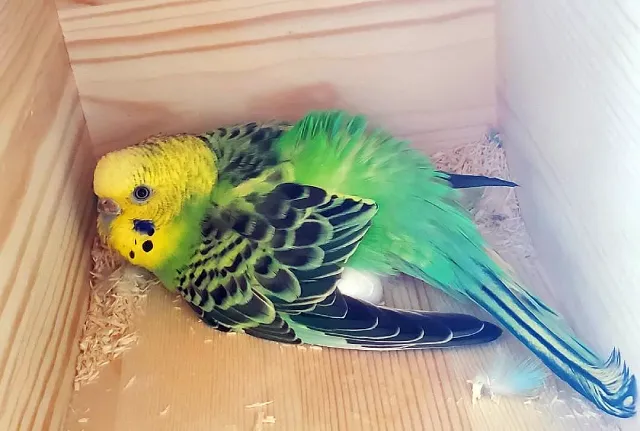
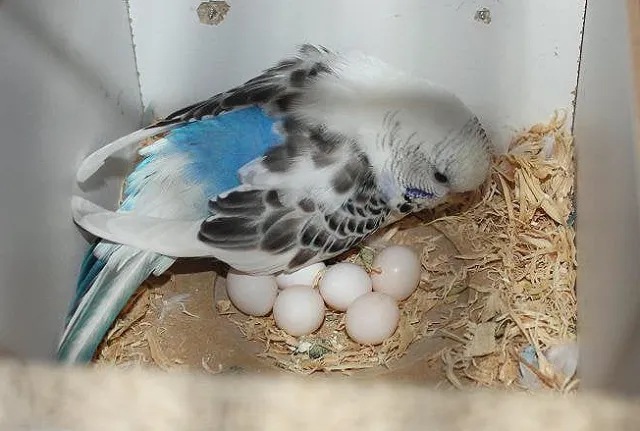
Understanding the Budgie Egg Life Cycle
The budgie egg life cycle is an intricate process marked by carefully timed events.
It’s crucial to have a clear understanding of this cycle for successful budgie breeding.
Egg-Laying and Incubation
A female budgie, after forming a pair, will typically lay her first egg roughly 10-14 days after successful mating. These eggs, numbering around 6 or 7 in total, are laid on alternate days.
The incubation period lasts for about 18 days, during which the mother budgie will spend most of her time in the nesting box, providing warmth necessary for the embryos’ development.
If all goes well, the eggs should hatch on alternate days, adhering to the egg-laying schedule.
During this period, it’s essential to provide a diet rich in nutrients, particularly proteins, fats, carbohydrates, vitamins, and minerals to support the mother’s reproductive needs.
Breeding pellets and fresh water are crucial at this stage, along with protein sources like boiled eggs, calcium sources like cuttlebones, and a variety of fruits and vegetables.

Budgie Chick Care: From Hatchlings to Weaned Budgies
Once the chicks hatch, they require attentive care for proper growth and development.
Hand-Feeding Budgie Chicks
Hand-feeding budgie chicks is often an integral part of breeding budgies, especially if the mother hen has difficulty feeding her young or if the breeder needs to intervene for the chicks’ welfare.
While the process can be challenging, it’s often rewarding, helping to establish strong bonds between the chicks and their caretaker.
Firstly, it’s essential to prepare a suitable diet. A common choice among breeders is an egg and biscuit mix, which is rich in protein and promotes healthy feather growth.
This mix can be moistened to a suitable consistency for the chicks.
To hand-feed the chicks, one should use a small syringe or a specially designed bird-feeding spoon to carefully deliver the food into the chick’s mouth.
This should be done gently and patiently, ensuring that the chick is comfortable and not at risk of choking.
Throughout this process, fresh water should be readily available. As mentioned earlier, water is crucial for budgies, particularly during the breeding period.
Weaning Budgies: When and How to Do It Properly
Weaning is a significant step in a budgie chick’s life, signifying its transition from dependence on parents to self-feeding.
Budgie chicks typically leave the nest box at around 30-32 days old, fully feathered.
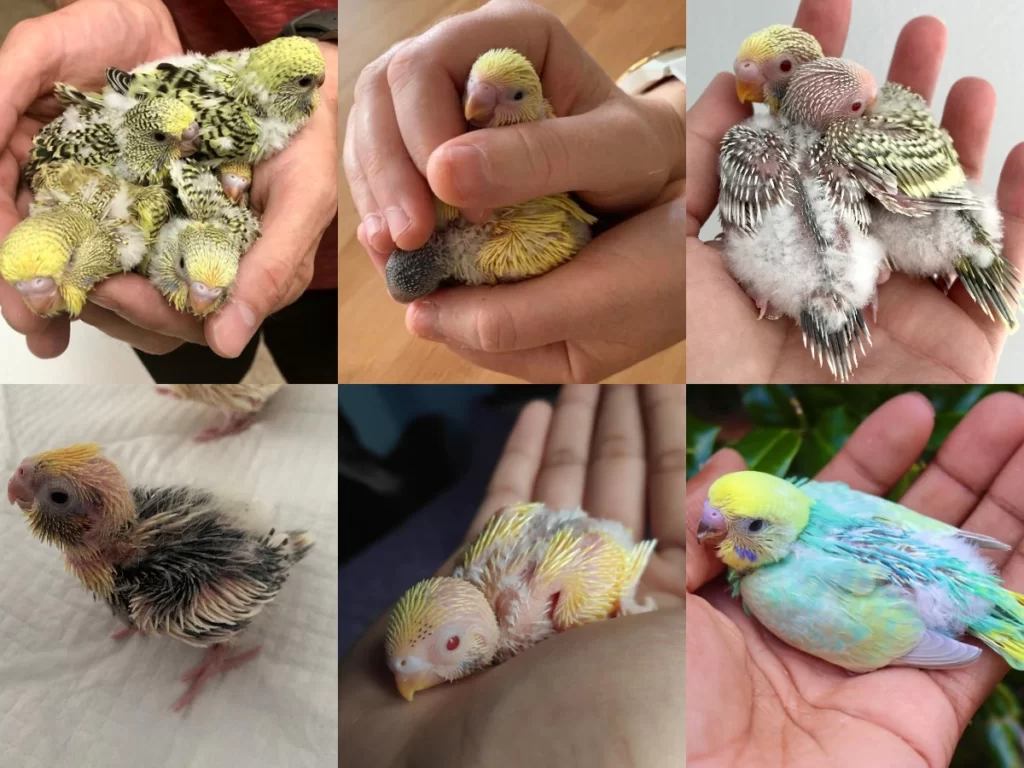
This period also often coincides with the mother budgie’s next egg-laying cycle.
As the chicks leave the nest, they gradually learn to eat solid food and become less dependent on their parents for nourishment.
Weaning should never be rushed, and chicks should have access to a well-balanced diet that includes seeds, sprouted seeds, fresh fruits, and vegetables.
Strategies for Fostering Budgie Chicks
Successful fostering of budgie chicks requires a balanced blend of optimal nutrition, a safe and comfortable living environment, and careful monitoring of their development stages.
Joining a local club or society for bird keepers can be a great way to learn from experienced breeders and develop a supportive network as you embark on this fulfilling journey.
Budgie Breeding Challenges and Solutions
Breeding budgies is a rewarding yet intricate task that involves an in-depth understanding of their behavior, dietary requirements, and potential health issues.
With careful planning, a thorough understanding of their needs, and prompt problem resolution, you can successfully navigate these hurdles.
Let’s delve into some of the common challenges encountered during budgie breeding and their possible solutions.
Common Challenges and Health Issues in Budgie Breeding
1. Choosing a Suitable Pair
Choosing a suitable pair for breeding is the first and fundamental step.
The birds should be healthy, active, and of breeding age, which is usually around 1 year.
Selecting a pair with harmonious temperaments is equally essential, as this can significantly influence their breeding success.
2. Determining the Sex of Budgies
Sex determination in budgies can be tricky, especially for inexperienced breeders. However, a general rule of thumb is to observe the color of their cere (the area around their nostrils).
In mature males, it is typically bright blue, while in females, it varies from white to brown.
3. Poor Nutrition
A balanced diet high in protein, fats, carbohydrates, vitamins, and minerals is essential, especially during the breeding period.
Nutritional deficiencies can lead to weak chicks, low hatch rates, and health problems in parent birds.
Consider incorporating items like boiled eggs, fresh fruits, vegetables, sprouted seeds, special breeding pellets, and fresh water into their diet.
4. Egg Binding
Egg binding, a condition where the female budgie struggles to expel the egg from her body, is a severe health issue that can occur due to insufficient calcium intake.
To mitigate this risk, increase the intake of calcium during the breeding period through sources like cuttlebones, eggshells, or calcium supplements.
5. Splayed Legs in Chicks
This is a condition where a chick’s legs are abnormally spread apart, impairing its mobility.
It can result from a slippery floor in the nesting box, leading to the chick’s legs sliding sideways.
To prevent this, ensure the nest box floor has a texture or material like a paper towel to provide grip for the chick’s feet.
6. Inadequate Nesting Conditions
Budgies require a specific environment to breed successfully. Nest boxes should be at the same height to prevent conflicts among the hens for the top box.
The boxes can be attached either inside or outside the cage, depending on the cage’s size.
7. Parent Birds Not Feeding the Chicks
Occasionally, parent birds might neglect or be incapable of feeding their chicks, which can lead to the chicks’ death if not addressed promptly.
In such cases, you might need to hand-feed the chicks using a bird-specific formula until they can eat independently.
8. Aggression and Bullying
In a colony breeding set-up, budgies may display aggressive behavior, leading to injuries or stress among the birds.
One way to handle this is by initially pair-bonding the birds in separate cages, then releasing several pairs into the aviary at once to decrease aggression.
9. Genetic Issues
When breeding budgies, it’s crucial to understand some basic genetics to avoid health problems associated with inbreeding.
You might want to start with the colors you find attractive, gradually learning about budgie genetics along the way.
10. Overbreeding
Overbreeding can exhaust the parent birds and lead to weaker offspring. The breeding cycle should be regulated, allowing the budgies sufficient time to rest and recover between breeding seasons.
Reasons Why Budgies Do Not Want to Mate and Breed?
Budgie breeders often encounter difficulties when their budgies do not want to mate and breed.
There are numerous factors that might contribute to this, some of which are listed below.
1. Incorrect Age
A budgie’s age can greatly influence their breeding capabilities. Budgies become sexually mature around the age of 3-4 months, but this is not the optimal age for breeding.
Budgies should ideally be at least a year old before they breed.
Attempting to breed them too early can lead to complications and an unsuccessful breeding process. In addition, older budgies may not prefer to mate.
2. Mismatched Pairs
Not all pairs of budgies will be compatible for breeding. It’s essential to ensure both the male and female budgie are comfortable with each other.
If the pair isn’t well matched, they may not mate, which prevents the breeding process from taking place.
3. Out of Breeding Season
Budgies, like many bird species, have a specific breeding season – typically during the spring.
If you’re attempting to breed your budgies outside this season, they may not be in the mood to mate.
4. Insufficient Light
Budgies require an appropriate amount of light exposure to breed. A day length of around 12 hours of light and 12 hours of darkness often stimulates budgies to breed.
If the light exposure is insufficient, it may affect their breeding behaviour.
5. Unsuitable Nesting Conditions
Budgies need a suitable and safe nesting environment to breed. If the nesting box conditions aren’t comfortable and secure, they may not be encouraged to mate.
The nesting box should be placed at the same height as other boxes in a colony system to avoid fights for the top box.
6. Stressful Environment
A stressful environment can significantly hamper a budgie’s willingness to breed. Stress can be caused by various factors, such as sudden changes in environment, excessive noise, or presence of predators.
A calm and consistent environment is vital for successful breeding.
7. Overbreeding
Overbreeding can also be a factor in budgies not wanting to mate.
If a budgie pair has been bred multiple times over a short period, they may become exhausted and not want to mate.
It’s important to give budgies a rest between breeding cycles.
8. Health Problems
If a budgie is not in good health, they will be less likely to mate.
It’s essential to ensure your budgies are well-fed with a balanced diet rich in proteins, vitamins, and minerals and that they are free from diseases or infections.
9. Lack of Privacy
Budgies need privacy to mate. If the environment is too crowded or there’s too much human interaction, they may not mate.
Privacy can be provided by placing the cage in a quiet area and reducing unnecessary disturbances.
What Should You Do If You Don’t Want Your Budgies to Breed?
If you don’t want your budgies to breed, there are several actions you can take.
First, you can separate males and females into different cages to prevent mating.
Alternatively, you can replace real eggs with dummy eggs, which can discourage further egg-laying without causing stress from removing the eggs.
How Do Dummy Eggs Help in Budgie Breeding?
Dummy eggs play a crucial role in budgie breeding. When a budgie lays eggs and then adding dummy eggs can trick her into believing she has fulfilled her egg-laying cycle.
This can help control the number of eggs a budgie lays, preventing overbreeding and the associated health risks.
It also helps breeders manage the breeding process more efficiently.
Budgie Genetics: The Role of Selective Breeding
Selective breeding plays a critical role in budgie genetics, particularly when it comes to the vivid and varied colors of these small parakeets.
As breeders, the choices made in pair selection can significantly affect the appearance and health of the offspring.
To start with, budgies come in an array of colors and patterns, from the bright greens of the wild type to the stunning blues, yellows, and whites of selectively bred birds.
Additionally, there are intriguing patterns and variations such as Lutinos, Albinos, Clearwings, Spangles, and Pieds.
These varieties are all thanks to the laws of genetics and the careful selection of breeding pairs by budgie enthusiasts.
For the novice breeder, understanding genetics might seem like a daunting task.
However, while there is indeed some complexity involved, the basics are quite straightforward.
The important thing is to enjoy the process and start with the colors and patterns you find most appealing.
As you gain experience, you can delve deeper into the world of budgie genetics.
Experiment with different pairings, observe the outcomes, and learn more about how certain traits are inherited.
Budgie Breeding Tips
Budgie breeding is a fascinating and rewarding hobby. Here are some essential tips to guide you:
- Nutrition: Ensure the budgies have a diet rich in proteins, fats, carbohydrates, vitamins, and minerals. This can be achieved through a good mix of seeds, boiled eggs, legumes, fresh fruits, vegetables, sprouted seeds, and specially designed breeding pellets.
- Calcium: Increase the calcium intake during the breeding period to aid in egg production. This can be achieved through cuttlebones, eggshells, or calcium supplements.
- Hydration: Provide fresh water always. This is critical as birds drink more during the breeding period. Water is also needed for bathing and humidifying the nest.
- Nest Boxes: Budgies breed in a nest box. Ensure that all nest boxes are placed at the same level to prevent competition among hens.
- Colony System: Budgies are colony birds and breed better in groups. To manage competitiveness among the birds, consider pair-bonding in separate cages before releasing them into the aviary.
- Consistency: Keep track of the breeding cycle. A hen usually lays 6 or 7 eggs in total on alternate days. The incubation period is approximately 18 days, and the chicks jump out of the box at about 30 to 32 days old, fully feathered.
- Patience and Persistence: Challenges are part of the breeding process. Don’t be discouraged by initial difficulties; they’re all part of the game.
Specialized and Advanced Budgie Breeding
Breeding Budgies for Exhibiting (Show Budgies, Exhibiting Budgies)
Taking your budgie breeding to the next level involves producing show-quality birds.
These budgies, often larger and more vibrantly colored than their pet counterparts, require a deeper understanding of budgie genetics and care.
Firstly, the seed mix is vital for these birds. As the larger exhibition birds carry much more feather, they need more protein-rich seeds, such as the canary seeds included in high-end mixes.
Secondly, they require a specialized rearing food when hens are raising chicks.
This food is typically a high-protein egg and biscuit mix that supports the growth of the chicks and their feathers.
Thirdly, showing budgies is not just about the birds but also about the social aspect of the hobby.
Participating in shows and being part of clubs and societies can be immensely rewarding.
There, you can share experiences, learn from others, and even compete in classes for each of the colors.
While breeding budgies for exhibition can be a more involved and potentially expensive aspect of the hobby, the potential rewards – both personal and competitive – make it an appealing goal for many breeders.
The Social Aspect of Budgie Breeding – Clubs and Societies, Sales and Events
Breeding budgies, a rewarding communal hobby, is enhanced by global clubs and societies that offer information, guidance, and camaraderie.
These organizations, from local to regional levels, host meetings and events to promote knowledge exchange and shared experiences.
Participating in such communities also provides competitive breeding opportunities following national standards.
Increasingly popular are sales events, which not only facilitate social interaction among breeders but also provide a venue to sell surplus birds.
The social aspect of budgie breeding involves the whole family, offering a shared source of entertainment and bonding beyond the act of breeding.
Embracing Ethical and Responsible Budgie Breeding Practices
Breeding budgies should never be reduced to a commercial enterprise. It’s a hobby centered on the joy these birds bring and the pleasure derived from observing their behavior, colors, and the miracle of their breeding cycle.
It’s vital to prioritize the well-being of the budgies. This includes ensuring they have a diet high in nutritional content, providing a suitable environment for breeding, and avoiding overbreeding.
These practices ensure the happiness and health of the budgies, making the hobby even more rewarding.
FAQs
Can One Male Budgie Mate with Two Females?
Typically, a budgie pair consists of one male and one female. Introducing a second female to the mix can lead to conflicts and isn’t recommended.
Why Do Two Male Budgies Try to Mate?
Two male budgies may display mating behaviors as a form of dominance display or due to a lack of females in the environment.
This is common and usually doesn’t cause harm.
Can 5 Months Old Budgies Breed?
Although budgies reach sexual maturity around 3-4 months of age, it’s not recommended to allow them to breed until they’re at least one year old.
This ensures they’re physically and emotionally mature enough to handle breeding.
How to Breed Budgies Fast at Home?
Successful and responsible budgie breeding requires patience. It’s essential to provide an optimal environment, proper nutrition, and adequate nest boxes.
However, rushing the breeding process can lead to unhealthy or stressed birds, so it’s best to allow nature to take its course.
What Is Budgie Breeding Bloodline Records (Family Tree for Budgies)?
Keeping records of your budgies’ bloodlines can be an essential part of the breeding process.
This allows you to track genetic traits, monitor health issues, and ensure a diverse gene pool.
It involves documenting the lineage of each bird, including its parents, offspring, and notable traits.
How Important Is the Role of Diet in Budgie Breeding?
Diet plays a crucial role in budgie breeding. During breeding, the dietary needs of budgies increase significantly to support egg production and chick growth.
They require a balanced diet with enhanced levels of protein, calcium, phosphorus, Vitamin D3, and other vitamins and minerals.
Special breeding pellets are often recommended to meet these nutritional needs.
What Measures Can Be Taken If Budgie Pairs Do Not Get Along?
If the budgies you put together to mate don’t like each other, it’s essential to respond promptly to avoid stress and potential aggression. You may have to separate them temporarily and reintroduce them gradually, or in severe cases, consider finding different partners for them.
Observing the compatibility of potential pairs before mating can help avoid such scenarios.
What Are Some Signs That Indicate a Budgie Is Ready to Mate?
Identifying signs of readiness for mating in budgies is key to successful breeding.
Male budgies show readiness through behaviors like increased singing and chirping, bobbing head, flapping wings, feeding the female, and nest making. Females may exhibit fluffed feathers around the vent area, tail raising, receptiveness to the male’s actions, and entering the nesting box among other behaviors.
What Are the Most Common Challenges Encountered in Budgie Breeding and How Can They Be Overcome?
Budgie breeding can pose challenges like choosing a suitable pair, determining the sex of budgies, managing nutrition, egg binding, inadequate nesting conditions, and issues related to chick care, among others.
Overcoming these issues requires careful observation, knowledge, and patience. Adequate preparations, creating a suitable breeding environment, ensuring proper diet, and good mate selection can help prevent many of these issues.
How Can You Encourage Ethical and Responsible Budgie Breeding Practices?
Promoting ethical budgie breeding involves prioritizing the birds’ wellbeing over commercial interests.
It involves maintaining good living conditions, preventing overbreeding, ensuring adequate diet, and promoting genetic diversity. Encouraging others to adopt these practices and getting involved in budgie societies can help foster a culture of responsible breeding.
Sources & Further Readings
- https://haiths.com/blogs/cage-aviary-blogs/budgie-breeding-making-that-start-with-budgies (archived)
- https://www.fred-wright.co.uk/faqs.html (archived)
- https://theses.gla.ac.uk/76267/1/13833998.pdf (archived)
- https://citeseerx.ist.psu.edu/document?repid=rep1&type=pdf&doi=5b9ca5cd0d49287244af23c67125dd5dd10171b3 (Archived)

